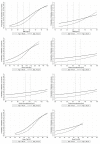The Prevalence of Diabetes among Hypertensive Polish in Relation to Sex-Difference in Body Mass Index, Waist Circumference, Body Fat Percentage and Age
- PMID: 35954813
- PMCID: PMC9367793
- DOI: 10.3390/ijerph19159458
The Prevalence of Diabetes among Hypertensive Polish in Relation to Sex-Difference in Body Mass Index, Waist Circumference, Body Fat Percentage and Age
Erratum in
-
Correction: Bednarek et al. The Prevalence of Diabetes among Hypertensive Polish in Relation to Sex-Difference in Body Mass Index, Waist Circumference, Body Fat Percentage and Age. Int. J. Environ. Res. Public Health 2022, 19, 9458.Int J Environ Res Public Health. 2023 May 16;20(10):5834. doi: 10.3390/ijerph20105834. Int J Environ Res Public Health. 2023. PMID: 37239644 Free PMC article.
Abstract
Background: Little is known about sex differences in the risk of type 2 diabetes (DM2) development related to body fat depot. The main aim of this study was to assess sex-specific differences in the prevalence of diabetes in the relation to body mass, body mass index (BMI), waist circumference (WC), and calculated body fat percentage (BF), adjusted by physical activity, in younger and older hypertensive adults. Subjects/Methods: The survey enrolled 12,289 adult hypertensive outpatients with body weight, height, and WC reported by their physicians across Poland. Prevalence of diabetes was plotted against body mass, BMI, WC, and calculated BF and adjusted by the self-reported level of physical activity. Results: In our cohort, younger women (<60 years) with BMI < 25.0 kg/m2 had lower adjusted prevalence of diabetes than corresponding men (3.4% vs. 6.5%), while among older (≥60 years) with BMI < 25.0 kg/m2, the prevalence of diabetes was greater in women than in men (19.4% vs. 11.2%). A 25% probability of diabetes was observed for younger women with lower BMI than younger men (32.1 kg/m2 and 35.3 kg/m2, respectively) and WC (100.7 cm and 116.1 cm, respectively) but greater BF (45.5% and 38.9%, respectively). The corresponding differences in BMI and WC in older ones were much smaller (27.6 kg/m2 and 27.2 kg/m2, respectively; 83.7 cm and 85.6 cm, respectively), but not for BF (40.7% and 30.1%, respectively). A doubling of diabetes probability (from 25% to 50%), adjusted by physical activity, was attributable to the lower increase in BMI and WC and BF in women than in men (6.3 vs. 9.8 kg/m2, 25.0 vs. 36.1 cm, and 6.5 vs. 10.8%, for younger, and 8.1 vs. 11.3 kg/m2, 26.2 vs. 73.2 cm and 8.8 vs. 13.3%, for older). Conclusions: This study shows a lower probability of diabetes in younger women than younger men with normal weight BMI ranges, adjusted to physical activity. This probability is greater for hypertensive women, regardless of age, due to the increase in BMI/WC and BF values adjusted for physical activity.
Keywords: epidemiology; obesity; physical activity; sex-specific effect; visceral obesity.
Conflict of interest statement
The authors declare no conflict of interest.
Figures



References
-
- Hill J.J. Obesity: An emerging threat. J. Natl. Black Nurses Assoc. JNBNA. 2018;29:36–39. - PubMed
-
- Makizako H., Shimada H., Doi T., Tsutsumimoto K., Lee S., Lee S.C., Harada K., Hotta R., Nakakubo S., Bae S., et al. Age-dependent changes in physical performance and body composition in community-dwelling Japanese older adults. J. Cachexia Sarcopenia Muscle. 2017;8:607–614. doi: 10.1002/jcsm.12197. - DOI - PMC - PubMed
Publication types
MeSH terms
LinkOut - more resources
Full Text Sources
Medical
Miscellaneous

